Solid Lipid Nanoparticles Embedded Hydrogels as a Promising Carrier for Retarding Irritation of Leflunomide
Abstract
1. Introduction
2. Results and Discussion
2.1. Characterizations of LEF-SLNs
2.1.1. Particle Size Distribution, Zeta Potential, and PDI
2.1.2. Surface Morphology
2.1.3. Total Drug Content and Entrapment Efficiency
2.1.4. FTIR Spectroscopy
2.1.5. XRD Analysis
2.2. Photostability Assessment
2.3. In Vitro Anti-Inflammatory Assay
2.4. Characterization of LEF-SLN-Based Hydrogels
2.5. Occlusion Testing
2.6. Spreadability
2.7. Drug Release
2.8. Irritation Behavior
3. Conclusions
4. Materials and Methods
4.1. Chemicals
4.2. Development of LEF-SLNs
4.3. Characterizations of LEF-SLNs
4.3.1. Particle Size, Zeta Potential, and Polydispersity Index (PDI) Evaluation
4.3.2. Surface Morphology
4.3.3. Total Drug Content and Entrapment Efficiency
4.3.4. FTIR Spectroscopy
4.3.5. X-ray Diffraction (XRD)
4.4. Photostability Analysis
4.5. In-Vitro Anti-Inflammatory Assay
4.6. Incorporation of LEF-SLN into Hydrogel Base
4.7. Visual Examination and pH Determination
4.8. Rheology and Textural Profile of Hydrogel
4.9. Occlusion Testing
4.10. Spreadability
4.11. In Vitro Drug Release
4.12. Irritation Behavior
4.13. Statistical Analysis
Author Contributions
Funding
Institutional Review Board Statement
Informed Consent Statement
Data Availability Statement
Acknowledgments
Conflicts of Interest
References
- Chen, L.; Deng, H.; Cui, H.; Fang, J.; Zuo, Z.; Deng, J.; Li, Y.; Wang, X.; Zhao, L. Inflammatory Responses and Inflammation-Associated Diseases in Organs. Oncotarget 2018, 9, 7204. [Google Scholar] [CrossRef] [PubMed]
- Nathan, C.; Ding, A. Nonresolving Inflammation. Cell 2010, 140, 871–882. [Google Scholar] [CrossRef] [PubMed]
- Furman, D.; Campisi, J.; Verdin, E.; Carrera-Bastos, P.; Targ, S.; Franceschi, C.; Ferrucci, L.; Gilroy, D.W.; Fasano, A.; Miller, G.W. Chronic Inflammation in the Etiology of Disease across the Life Span. Nat. Med. 2019, 25, 1822–1832. [Google Scholar] [CrossRef] [PubMed]
- Prado-Audelo, D.; Luisa, M.; Cortés, H.; Caballero-Florán, I.H.; González-Torres, M.; Escutia-Guadarrama, L.; Bernal-Chávez, S.A.; Giraldo-Gomez, D.M.; Magaña, J.J.; Leyva-Gómez, G. Therapeutic Applications of Terpenes on Inflammatory Diseases. Front. Pharmacol. 2021, 12, 2114. [Google Scholar] [CrossRef]
- Hasani, M.; Sani, N.A.; Khodabakhshi, B.; Arabi, M.S.; Mohammadi, S.; Yazdani, Y. Encapsulation of Leflunomide (LFD) in a Novel Niosomal Formulation Facilitated Its Delivery to THP-1 Monocytic Cells and Enhanced Aryl Hydrocarbon Receptor (AhR) Nuclear Translocation and Activation. DARU J. Pharm. Sci. 2019, 27, 635–644. [Google Scholar] [CrossRef]
- Aronson, J.K. (Ed.) Leflunomide and Teriflunomide. In Meyler’s Side Effects of Drugs, 16th ed.; Elsevier: Oxford, UK, 2016; pp. 498–511. ISBN 978-0-444-53716-4. [Google Scholar]
- Lu, Y.; Fan, L.; Yang, L.-Y.; Huang, F.; Ouyang, X. PEI-Modified Core-Shell/Bead-like Amino Silica Enhanced Poly (Vinyl Alcohol)/Chitosan for Diclofenac Sodium Efficient Adsorption. Carbohydr. Polym. 2020, 229, 115459. [Google Scholar] [CrossRef]
- Nanaki, S.G.; Andrianidou, S.; Barmpalexis, P.; Christodoulou, E.; Bikiaris, D.N. Leflunomide Loaded Chitosan Nanoparticles for the Preparation of Aliphatic Polyester Based Skin Patches. Polymers 2021, 13, 1539. [Google Scholar] [CrossRef]
- Pund, S.; Pawar, S.; Gangurde, S.; Divate, D. Transcutaneous Delivery of Leflunomide Nanoemulgel: Mechanistic Investigation into Physicomechanical Characteristics, in Vitro Anti-Psoriatic and Anti-Melanoma Activity. Int. J. Pharm. 2015, 487, 148–156. [Google Scholar] [CrossRef]
- Krishnan, Y.; Mukundan, S.; Akhil, S.; Gupta, S.; Viswanad, V. Enhanced Lymphatic Uptake of Leflunomide Loaded Nanolipid Carrier via Chylomicron Formation for the Treatment of Rheumatoid Arthritis. Adv. Pharm. Bull. 2018, 8, 257. [Google Scholar] [CrossRef]
- Zewail, M.; Nafee, N.; Helmy, M.W.; Boraie, N. Coated Nanostructured Lipid Carriers Targeting the Joints—An Effective and Safe Approach for the Oral Management of Rheumatoid Arthritis. Int. J. Pharm. 2019, 567, 118447. [Google Scholar] [CrossRef]
- Aundhia, C.; Kondhia, D.; Seth, A.; Patel, S.; Shah, N.; Gohil, D. Formulation and Evaluation of Leflunomide Loaded Magnetic Solid-Lipid Nanoparticles for The Targeted Therapy of Breast Cancer. Int. J. Pharm. Res. 2020, 12, 2024–2032. [Google Scholar] [CrossRef]
- Battaglia, L.; Gallarate, M. Lipid Nanoparticles: State of the Art, New Preparation Methods and Challenges in Drug Delivery. Expert Opin. Drug Deliv. 2012, 9, 497–508. [Google Scholar] [CrossRef]
- Waghule, T.; Gorantla, S.; Rapalli, V.K.; Shah, P.; Dubey, S.K.; Saha, R.N.; Singhvi, G. Emerging Trends in Topical Delivery of Curcumin through Lipid Nanocarriers: Effectiveness in Skin Disorders. AAPS PharmSciTech 2020, 21, 1–12. [Google Scholar] [CrossRef]
- Jacob, S.; Nair, A.B.; Shah, J.; Gupta, S.; Boddu, S.H.; Sreeharsha, N.; Joseph, A.; Shinu, P.; Morsy, M.A. Lipid Nanoparticles as a Promising Drug Delivery Carrier for Topical Ocular Therapy—An Overview on Recent Advances. Pharmaceutics 2022, 14, 533. [Google Scholar] [CrossRef]
- Mishra, V.; Bansal, K.K.; Verma, A.; Yadav, N.; Thakur, S.; Sudhakar, K.; Rosenholm, J.M. Solid Lipid Nanoparticles: Emerging Colloidal Nano Drug Delivery Systems. Pharmaceutics 2018, 10, 191. [Google Scholar] [CrossRef]
- Mahant, S.; Kumar, S.; Pahwa, R.; Kaushik, D.; Nanda, S.; Rao, R. Solid Lipid Nanoparticles in Drug Delivery for Skin Care. In Nanoparticulate Drug Delivery Systems; CRC Press: Boca Raton, FL, USA, 2019; p. 337. [Google Scholar]
- Palliyage, G.H.; Hussein, N.; Mimlitz, M.; Weeder, C.; Alnasser, M.H.A.; Singh, S.; Ekpenyong, A.; Tiwari, A.K.; Chauhan, H. Novel Curcumin-Resveratrol Solid Nanoparticles Synergistically Inhibit Proliferation of Melanoma Cells. Pharm. Res. 2021, 38, 851–871. [Google Scholar] [CrossRef]
- Souto, E.B.; Doktorovova, S. Solid Lipid Nanoparticle Formulations: Pharmacokinetic and Biopharmaceutical Aspects in Drug Delivery. Methods Enzymol. 2009, 464, 105–129. [Google Scholar]
- Kamboj, S.; Bala, S.; Nair, A.B. Solid lipid nanoparticles: An effective lipid based technology for poorly water soluble drugs. Int. J. Pharm. Sci. Rev. Res. 2010, 5, 78–90. [Google Scholar]
- Jenning, V.; Gohla, S.H. Encapsulation of Retinoids in Solid Lipid Nanoparticles (SLN). J. Microencapsul. 2001, 18, 149–158. [Google Scholar]
- Bhaskar, K.; Mohan, C.K.; Lingam, M.; Mohan, S.J.; Venkateswarlu, V.; Rao, Y.M.; Bhaskar, K.; Anbu, J.; Ravichandran, V. Development of SLN and NLC Enriched Hydrogels for Transdermal Delivery of Nitrendipine: In Vitro and In Vivo Characteristics. Drug Dev. Ind. Pharm. 2009, 35, 98–113. [Google Scholar] [CrossRef]
- Kaur, R.; Sharma, N.; Tikoo, K.; Sinha, V.R. Development of Mirtazapine Loaded Solid Lipid Nanoparticles for Topical Delivery: Optimization, Characterization and Cytotoxicity Evaluation. Int. J. Pharm. 2020, 586, 119439. [Google Scholar] [CrossRef] [PubMed]
- Shrotriya, S.; Ranpise, N.; Satpute, P.; Vidhate, B. Skin Targeting of Curcumin Solid Lipid Nanoparticles-Engrossed Topical Gel for the Treatment of Pigmentation and Irritant Contact Dermatitis. Artif. Cells Nanomed. Biotechnol. 2018, 46, 1471–1482. [Google Scholar] [CrossRef] [PubMed]
- Kumar, N.; Kumar, S.; Singh, S.P.; Rao, R. Enhanced Protective Potential of Novel Citronella Essential Oil Microsponge Hydrogel against Anopheles Stephensi Mosquito. J. Asia-Pac. Entomol. 2021, 24, 61–69. [Google Scholar] [CrossRef]
- Mehnert, W.; Mäder, K. Solid Lipid Nanoparticles: Production, Characterization and Applications. Adv. Drug Deliv. Rev. 2012, 64, 83–101. [Google Scholar] [CrossRef]
- Patel, D.K.; Kesharwani, R.; Kumar, V. Etodolac Loaded Solid Lipid Nanoparticle Based Topical Gel for Enhanced Skin Delivery. Biocatal. Agric. Biotechnol. 2020, 29, 101810. [Google Scholar] [CrossRef]
- Jenning, V.; Schäfer-Korting, M.; Gohla, S. Vitamin A-Loaded Solid Lipid Nanoparticles for Topical Use: Drug Release Properties. J. Control. Release 2000, 66, 115–126. [Google Scholar] [CrossRef]
- Maia, C.S.; Mehnert, W.; Schäfer-Korting, M. Solid Lipid Nanoparticles as Drug Carriers for Topical Glucocorticoids. Int. J. Pharm. 2000, 196, 165–167. [Google Scholar] [CrossRef]
- El-Sayyad, N.M.E.-M.; Badawi, A.; Abdullah, M.E.; Abdelmalak, N.S. Dissolution Enhancement of Leflunomide Incorporating Self-Emulsifying Drug Delivery Systems and Liquisolid Concepts. Bull. Fac. Pharm. Cairo Univ. 2017, 55, 53–62. [Google Scholar] [CrossRef]
- Effendy, I.; Maibach, H.I. Surfactants and Experimental Irritant Contact Dermatitis. Contact Dermat. 1995, 33, 217–225. [Google Scholar] [CrossRef]
- Kakkar, V.; Kaur, I.P.; Kaur, A.P.; Saini, K.; Singh, K.K. Topical Delivery of Tetrahydrocurcumin Lipid Nanoparticles Effectively Inhibits Skin Inflammation: In Vitro and in Vivo Study. Drug Dev. Ind. Pharm. 2018, 44, 1701–1712. [Google Scholar] [CrossRef]
- Mohammadi-Samani, S.; Zojaji, S.; Entezar-Almahdi, E. Piroxicam Loaded Solid Lipid Nanoparticles for Topical Delivery: Preparation, Characterization and in Vitro Permeation Assessment. J. Drug Deliv. Sci. Technol. 2018, 47, 427–433. [Google Scholar] [CrossRef]
- Pople, P.V.; Singh, K.K. Development and Evaluation of Topical Formulation Containing Solid Lipid Nanoparticles of Vitamin A. AAPS PharmSciTech 2006, 7, E63–E69. [Google Scholar] [CrossRef]
- Rathore, C.; Upadhyay, N.K.; Sharma, A.; Lal, U.R.; Raza, K.; Negi, P. Phospholipid Nanoformulation of Thymoquinone with Enhanced Bioavailability: Development, Characterization and Anti-Inflammatory Activity. J. Drug Deliv. Sci. Technol. 2019, 52, 316–324. [Google Scholar] [CrossRef]
- Righeschi, C.; Bergonzi, M.C.; Isacchi, B.; Bazzicalupi, C.; Gratteri, P.; Bilia, A.R. Enhanced Curcumin Permeability by SLN Formulation: The PAMPA Approach. LWT Food Sci. Technol. 2016, 66, 475–483. [Google Scholar] [CrossRef]
- Jagdale, S.C.; Patil, S.A.; Kuchekar, B.S.; Chabukswar, A.R. Preparation and Characterization of Metformin Hydrochloride- Compritol 888 ATO Solid Dispersion. J. Young Pharm. 2011, 3, 197–204. [Google Scholar] [CrossRef]
- Parvez, S.; Yadagiri, G.; Karole, A.; Singh, O.P.; Verma, A.; Sundar, S.; Mudavath, S.L. Recuperating the Biopharmaceutical Aspects of Amphotericin B and Paromomycin Using a Chitosan Functionalized Nanocarrier via Oral Route for Enhanced Anti-Leishmanial Activity. Front. Cell. Infect. Microbiol. 2020, 10, 576. [Google Scholar] [CrossRef]
- Wadekar, M.P.; Rode, C.V.; Bendale, Y.N.; Patil, K.R.; Prabhune, A.A. Preparation and Characterization of a Copper Based Indian Traditional Drug: Tamra Bhasma. J. Pharm. Biomed. Anal. 2005, 39, 951–955. [Google Scholar] [CrossRef]
- Gupta, B.; Dalal, P.; Rao, R. Cyclodextrin Decorated Nanosponges of Sesamol: Antioxidant, Anti-Tyrosinase and Photostability Assessment. Food Biosci. 2021, 42, 101098. [Google Scholar] [CrossRef]
- Kaltwasser, J.P.; Nash, P.; Gladman, D.; Rosen, C.F.; Behrens, F.; Jones, P.; Wollenhaupt, J.; Falk, F.G.; Mease, P. Efficacy and Safety of Leflunomide in the Treatment of Psoriatic Arthritis and Psoriasis: A Multinational, Double-Blind, Randomized, Placebo-Controlled Clinical Trial. Arthritis Rheum. Off. J. Am. Coll. Rheumatol. 2004, 50, 1939–1950. [Google Scholar] [CrossRef]
- Das, S.; Wong, A.B.H. Stabilization of Ferulic Acid in Topical Gel Formulation via Nanoencapsulation and PH Optimization. Sci. Rep. 2020, 10, 1–18. [Google Scholar] [CrossRef]
- Mortazavi, S.; Tabandeh, H. The Influence of Various Silicones on the Rheological Parameters of AZG Containing Silicone-Based Gels. Iran. J. Pharm. Res. 2005, 4, 205–211. [Google Scholar]
- Lee, C.H.; Moturi, V.; Lee, Y. Thixotropic Property in Pharmaceutical Formulations. J. Control. Release 2009, 136, 88–98. [Google Scholar] [CrossRef]
- Raza, K.; Singh, B.; Singla, N.; Negi, P.; Singal, P.; Katare, O.P. Nano-Lipoidal Carriers of Isotretinoin with Anti-Aging Potential: Formulation, Characterization and Biochemical Evaluation. J. Drug Target. 2013, 21, 435–442. [Google Scholar] [CrossRef] [PubMed]
- Jain, A.; Garg, N.K.; Jain, A.; Kesharwani, P.; Jain, A.K.; Nirbhavane, P.; Tyagi, R.K. A Synergistic Approach of Adapalene-Loaded Nanostructured Lipid Carriers, and Vitamin C Co-Administration for Treating Acne. Drug Dev. Ind. Pharm. 2016, 42, 897–905. [Google Scholar] [CrossRef] [PubMed]
- Kumar, S.; Prasad, M.; Rao, R. Topical Delivery of Clobetasol Propionate Loaded Nanosponge Hydrogel for Effective Treatment of Psoriasis: Formulation, Physicochemical Characterization, Antipsoriatic Potential and Biochemical Estimation. Mater. Sci. Eng. C 2021, 119, 111605. [Google Scholar] [CrossRef] [PubMed]
- Yang, Z.; Nie, S.; Hsiao, W.W.; Pam, W. Thermoreversible Pluronic® F127-Based Hydrogel Containing Liposomes for the Controlled Delivery of Paclitaxel: In Vitro Drug Release, Cell Cytotoxicity, and Uptake Studies. Int. J. Nanomed. 2011, 151, 15057. [Google Scholar] [CrossRef] [PubMed]
- Kumar, S.; Jangir, B.L.; Rao, R. Cyclodextrin Nanosponge Based Babchi Oil Hydrogel Ameliorates Imiquimod-Induced Psoriasis in Swiss Mice: An Impact on Safety and Efficacy. Micro Nanosyst. 2022, 14, 226–242. [Google Scholar]
- Savian, A.L.; Rodrigues, D.; Weber, J.; Ribeiro, R.F.; Motta, M.H.; Schaffazick, S.R.; Adams, A.I.; de Andrade, D.F.; Beck, R.C.; da Silva, C.B. Dithranol-Loaded Lipid-Core Nanocapsules Improve the Photostability and Reduce the in Vitro Irritation Potential of This Drug. Mater. Sci. Eng. C 2015, 46, 69–76. [Google Scholar] [CrossRef]
- Khan, A.S.; Shah, K.U.; Mohaini, M.A.; Alsalman, A.J.; Hawaj, M.A.A.; Alhashem, Y.N.; Ghazanfar, S.; Khan, K.A.; Niazi, Z.R.; Farid, A. Tacrolimus-Loaded Solid Lipid Nanoparticle Gel: Formulation Development and in Vitro Assessment for Topical Applications. Gels 2022, 8, 129. [Google Scholar] [CrossRef]
- El-Emam, G.A.; Girgis, G.N.; Hamed, M.F.; Soliman, O.A.E.-A.; Abd El Gawad, H. Formulation and Pathohistological Study of Mizolastine–Solid Lipid Nanoparticles–Loaded Ocular Hydrogels. Int. J. Nanomed. 2021, 16, 7775. [Google Scholar] [CrossRef]
- Raina, H.; Kaur, S.; Jindal, A.B. Development of Efavirenz Loaded Solid Lipid Nanoparticles: Risk Assessment, Quality-by-Design (QbD) Based Optimisation and Physicochemical Characterisation. J. Drug Deliv. Sci. Technol. 2017, 39, 180–191. [Google Scholar] [CrossRef]
- Shrivastava, S.; Kaur, C.D. Development of Andrographolide-Loaded Solid Lipid Nanoparticles for Lymphatic Targeting: Formulation, Optimization, Characterization, in Vitro, and in Vivo Evaluation. Drug Deliv. Transl. Res. 2022, 13, 1–17. [Google Scholar] [CrossRef]
- Park, S.; Baker, J.O.; Himmel, M.E.; Parilla, P.A.; Johnson, D.K. Cellulose Crystallinity Index: Measurement Techniques and Their Impact on Interpreting Cellulase Performance. Biotechnol. Biofuels 2010, 3, 1–10. [Google Scholar] [CrossRef]
- Gunathilake, K.; Ranaweera, K.; Rupasinghe, H.P. In Vitro Anti-Inflammatory Properties of Selected Green Leafy Vegetables. Biomedicines 2018, 6, 107. [Google Scholar] [CrossRef]
- Kumar, S.; Rao, R. Novel Dithranol Loaded Cyclodextrin Nanosponges for Augmentation of Solubility, Photostability and Cytocompatibility. Curr. Nanosci. 2021, 17, 747–761. [Google Scholar] [CrossRef]
- Dudhipala, N.; Gorre, T. Neuroprotective Effect of Ropinirole Lipid Nanoparticles Enriched Hydrogel for Parkinson’s Disease: In Vitro, Ex Vivo, Pharmacokinetic and Pharmacodynamic Evaluation. Pharmaceutics 2020, 12, 448. [Google Scholar] [CrossRef]
- Kumar, S.; Singh, K.K.; Rao, R. Enhanced Anti-Psoriatic Efficacy and Regulation of Oxidative Stress of a Novel Topical Babchi Oil (Psoralea Corylifolia) Cyclodextrin-Based Nanogel in a Mouse Tail Model. J. Microencapsul. 2019, 36, 140–155. [Google Scholar] [CrossRef]
- De Vringer, T. Topical Preparation Containing a Suspension of Solid Lipid Particles. U.S. Patent 5,667,800, 16 September 1997. [Google Scholar]
- Montenegro, L.; Parenti, C.; Turnaturi, R.; Pasquinucci, L. Resveratrol-Loaded Lipid Nanocarriers: Correlation between in Vitro Occlusion Factor and in Vivo Skin Hydrating Effect. Pharmaceutics 2017, 9, 58. [Google Scholar] [CrossRef]
- Doppalapudi, S.; Jain, A.; Chopra, D.K.; Khan, W. Psoralen Loaded Liposomal Nanocarriers for Improved Skin Penetration and Efficacy of Topical PUVA in Psoriasis. Eur. J. Pharm. Sci. 2017, 96, 515–529. [Google Scholar] [CrossRef]
- Kaur, H.; Ahuja, M.; Kumar, S.; Dilbaghi, N. Carboxymethyl Tamarind Kernel Polysaccharide Nanoparticles for Ophthalmic Drug Delivery. Int. J. Biol. Macromol. 2012, 50, 833–839. [Google Scholar] [CrossRef]

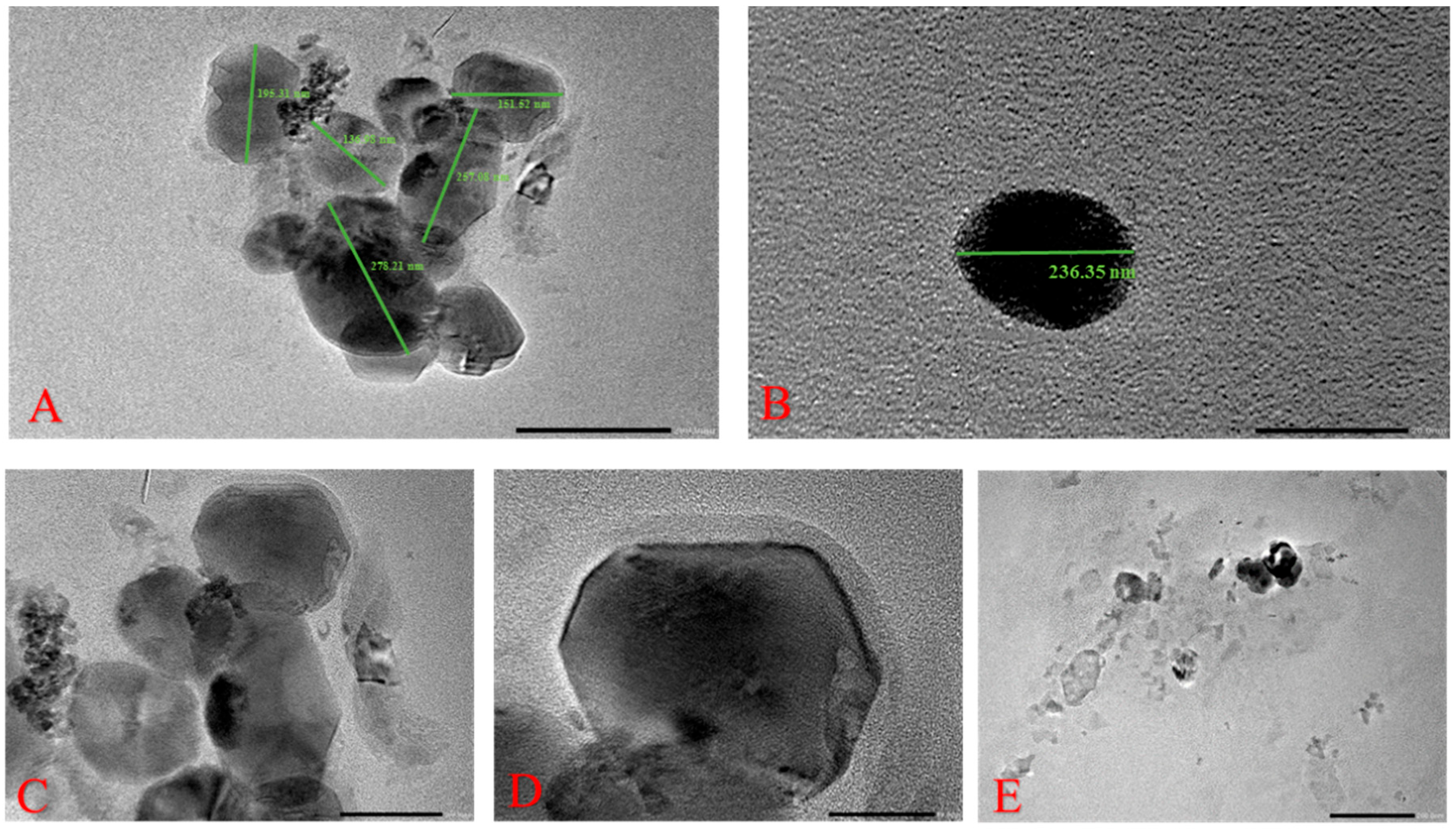
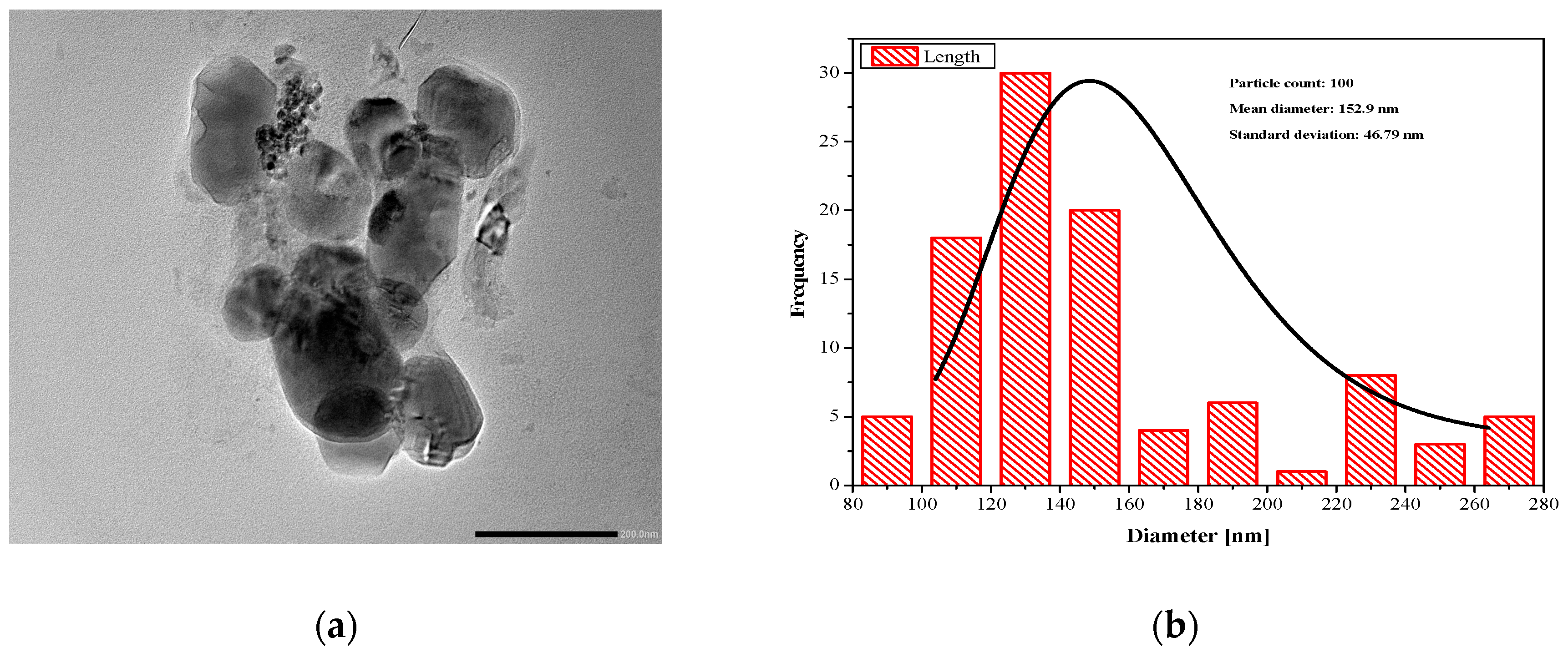
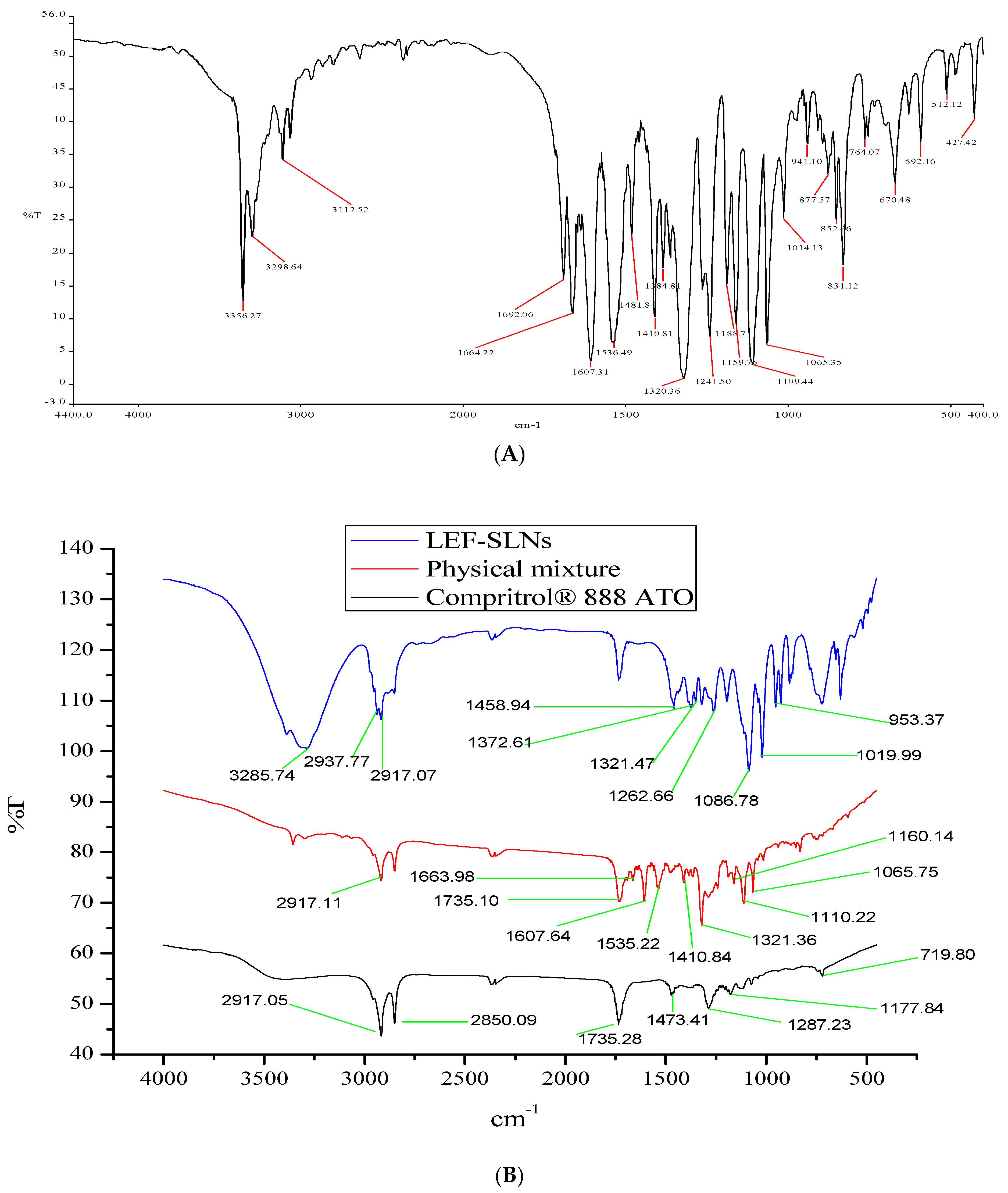
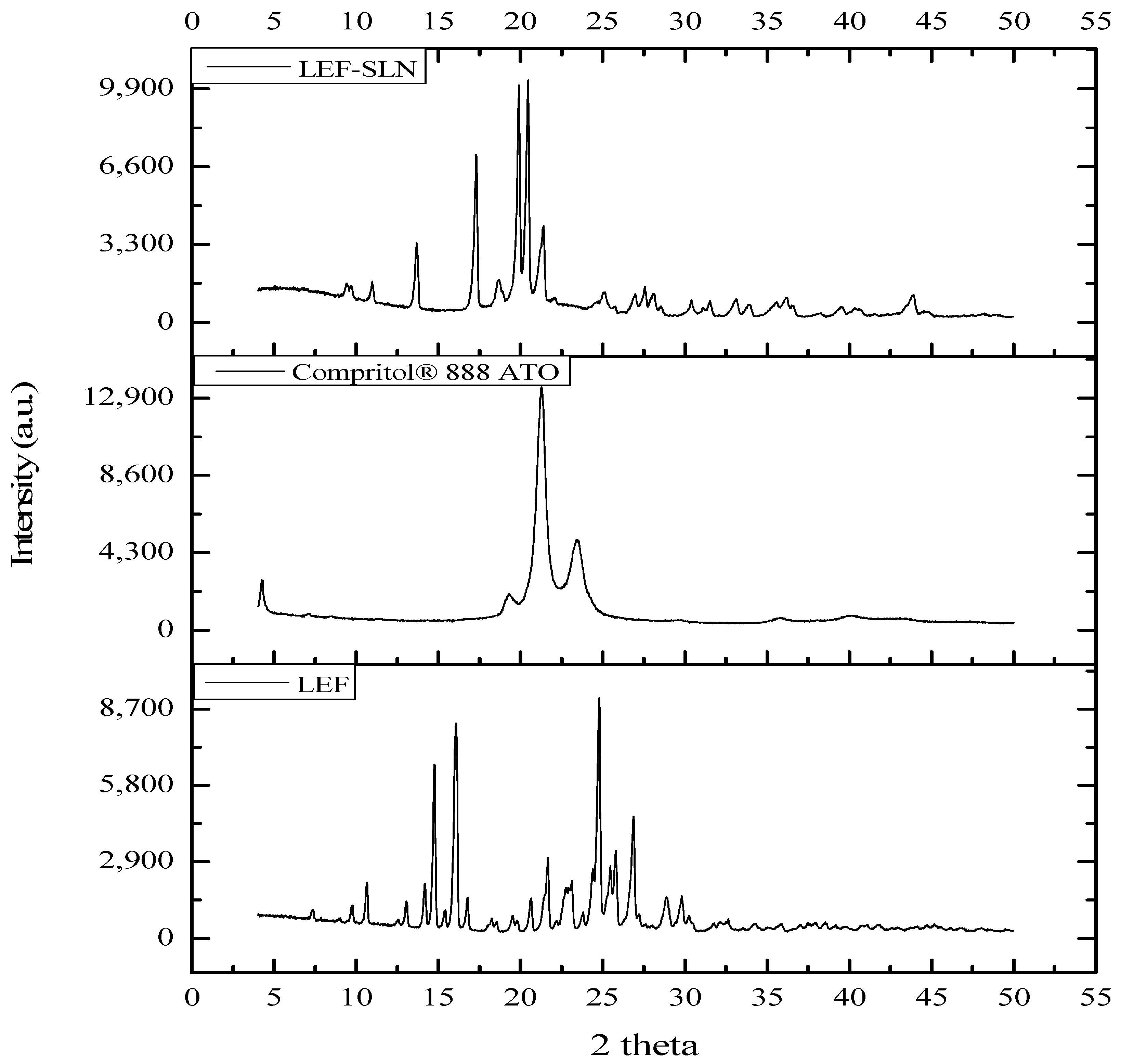
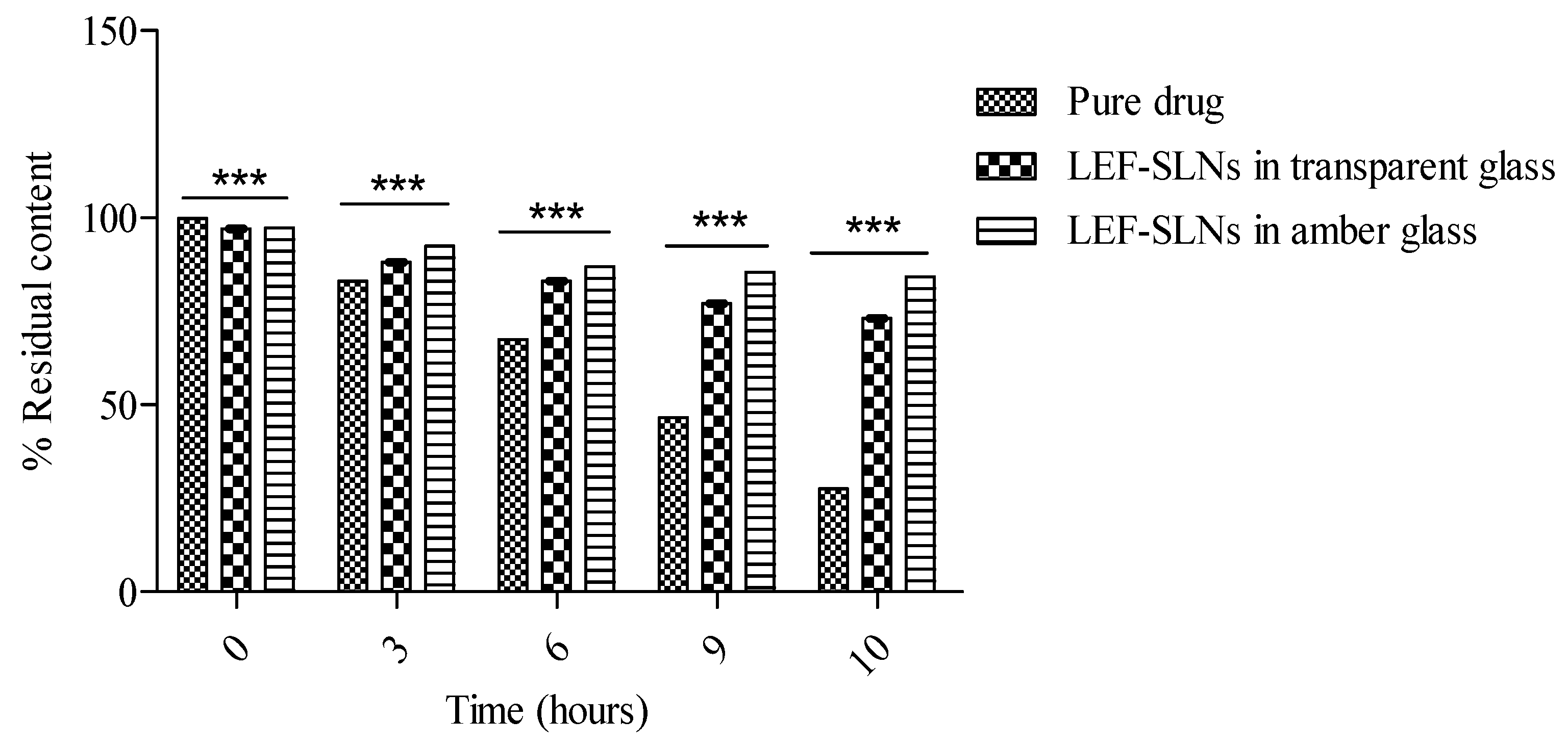
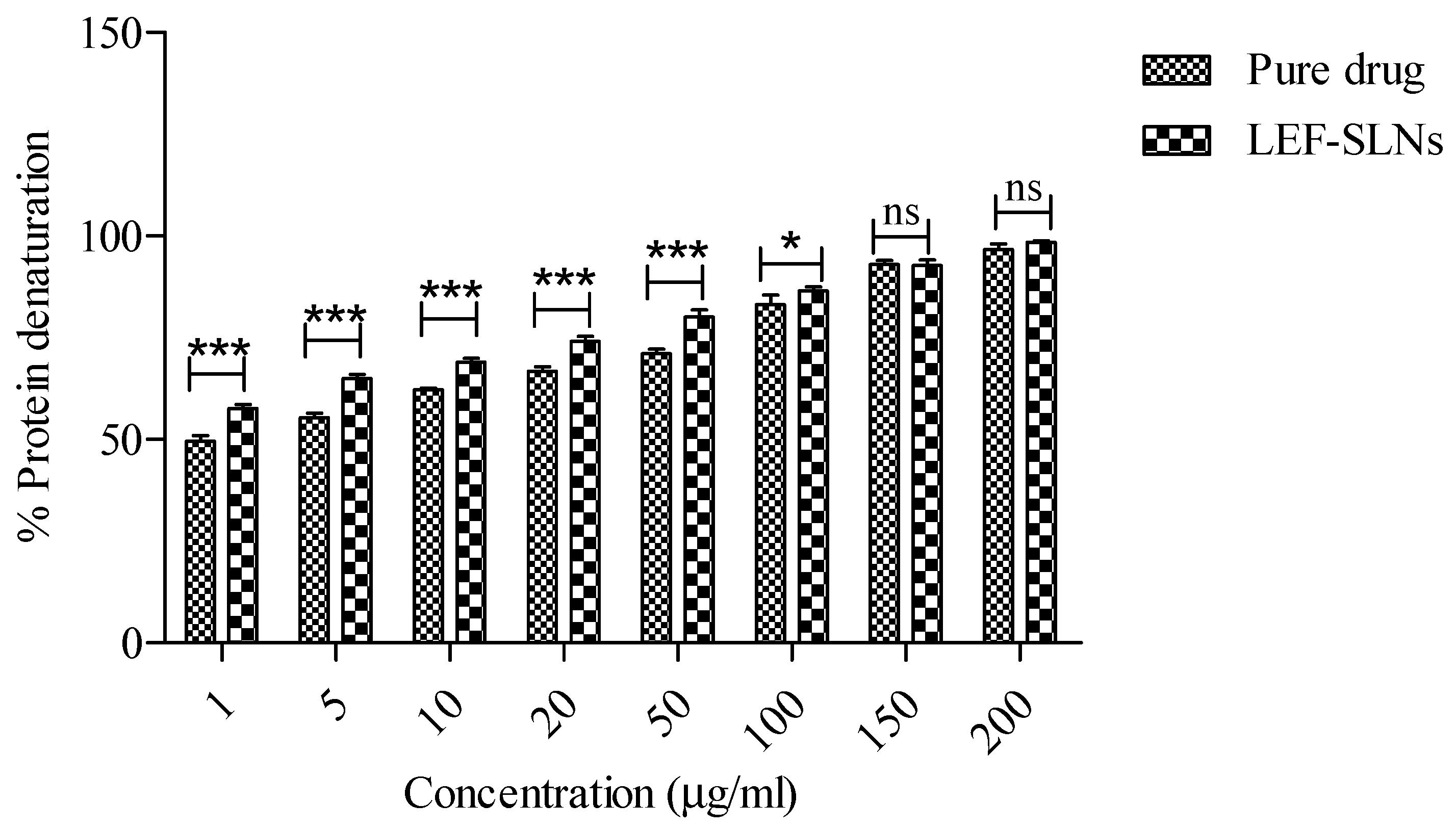
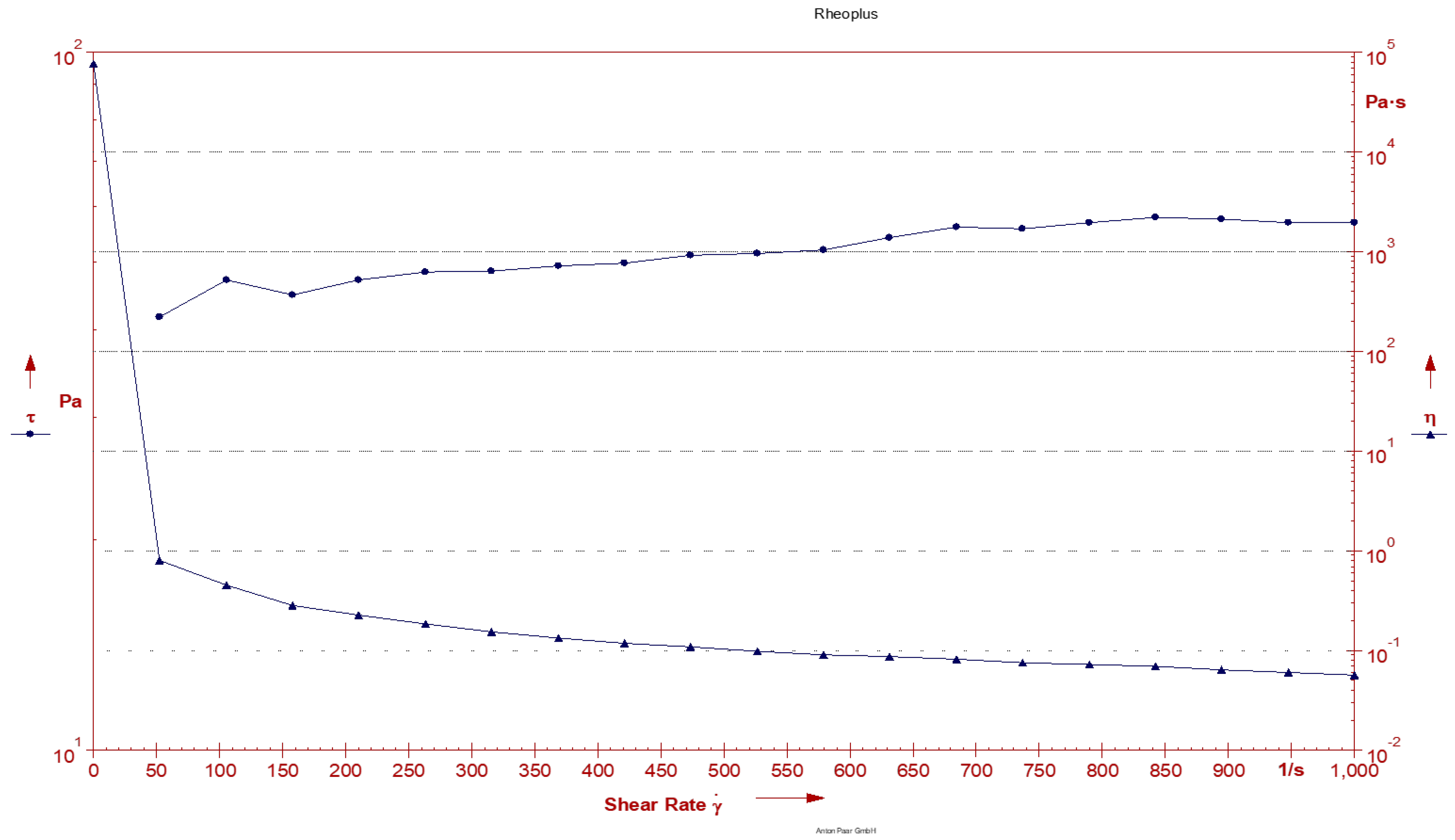
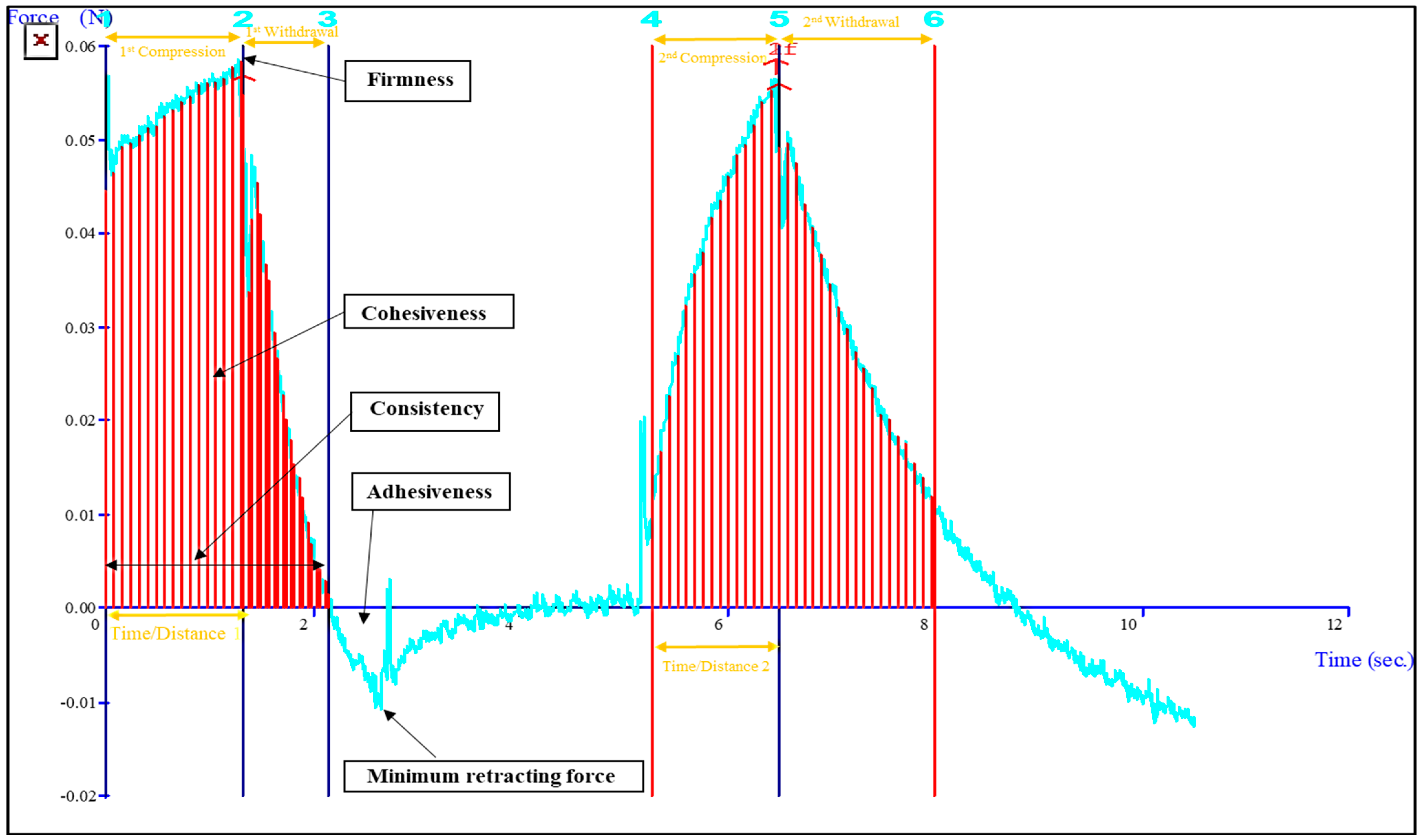
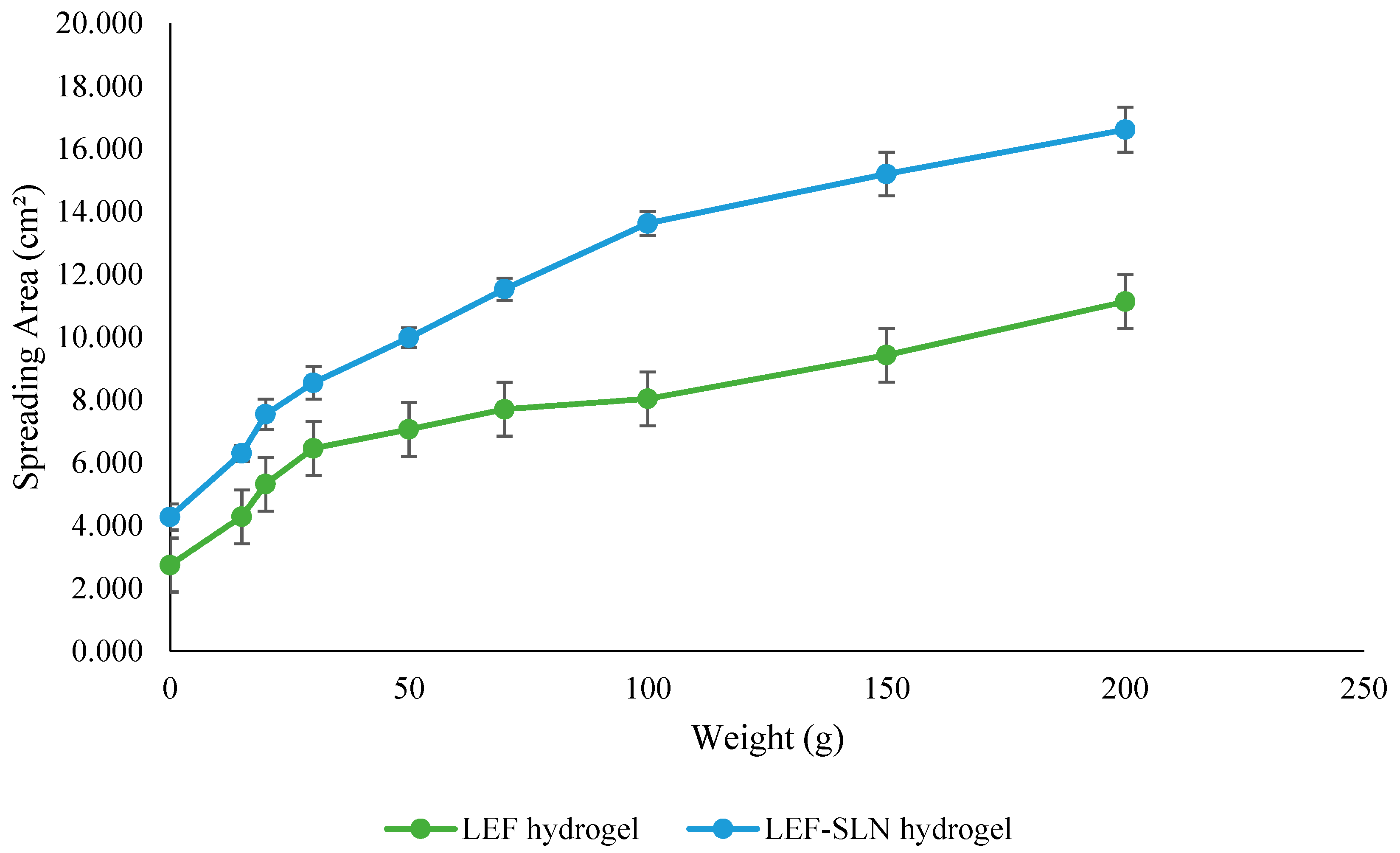
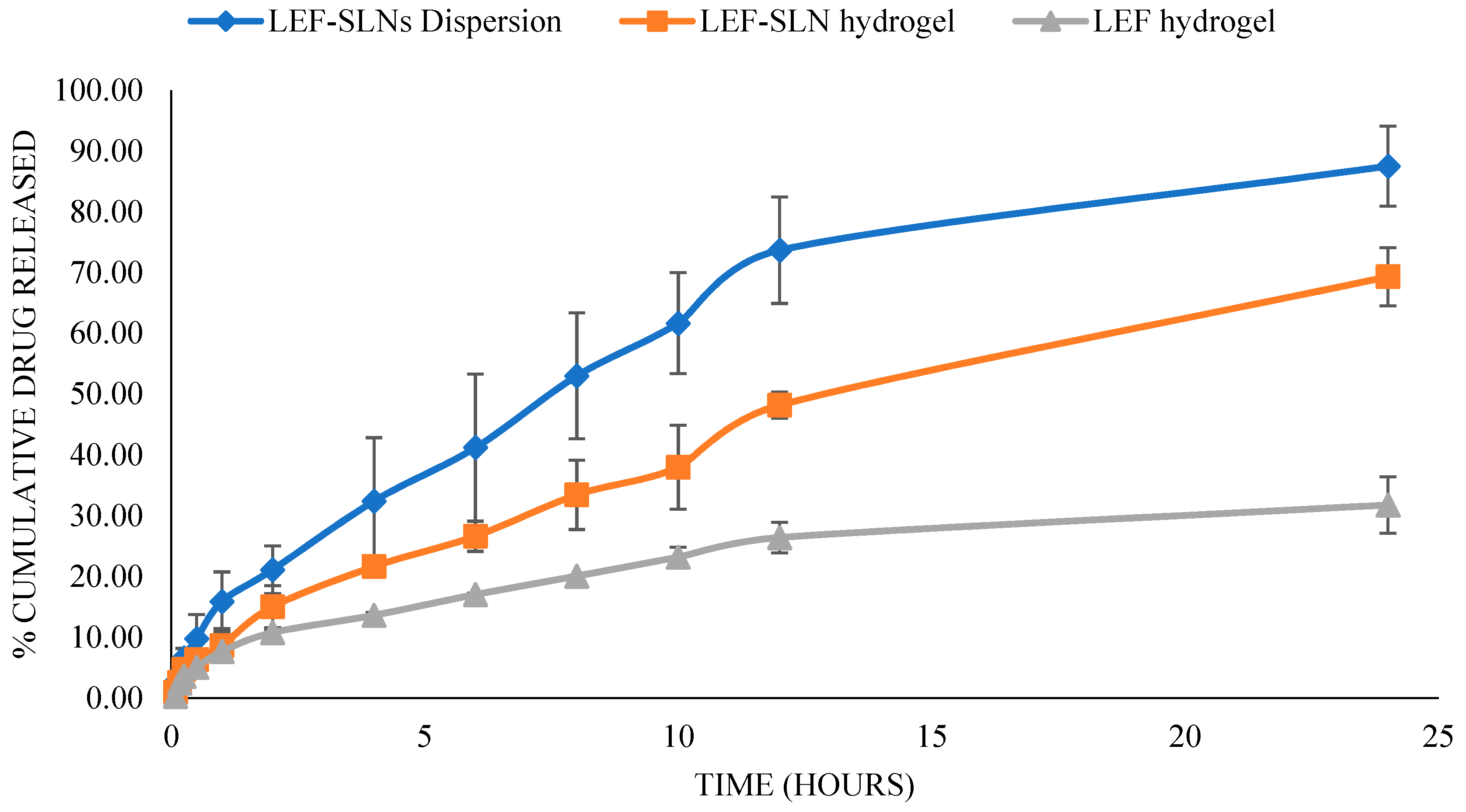
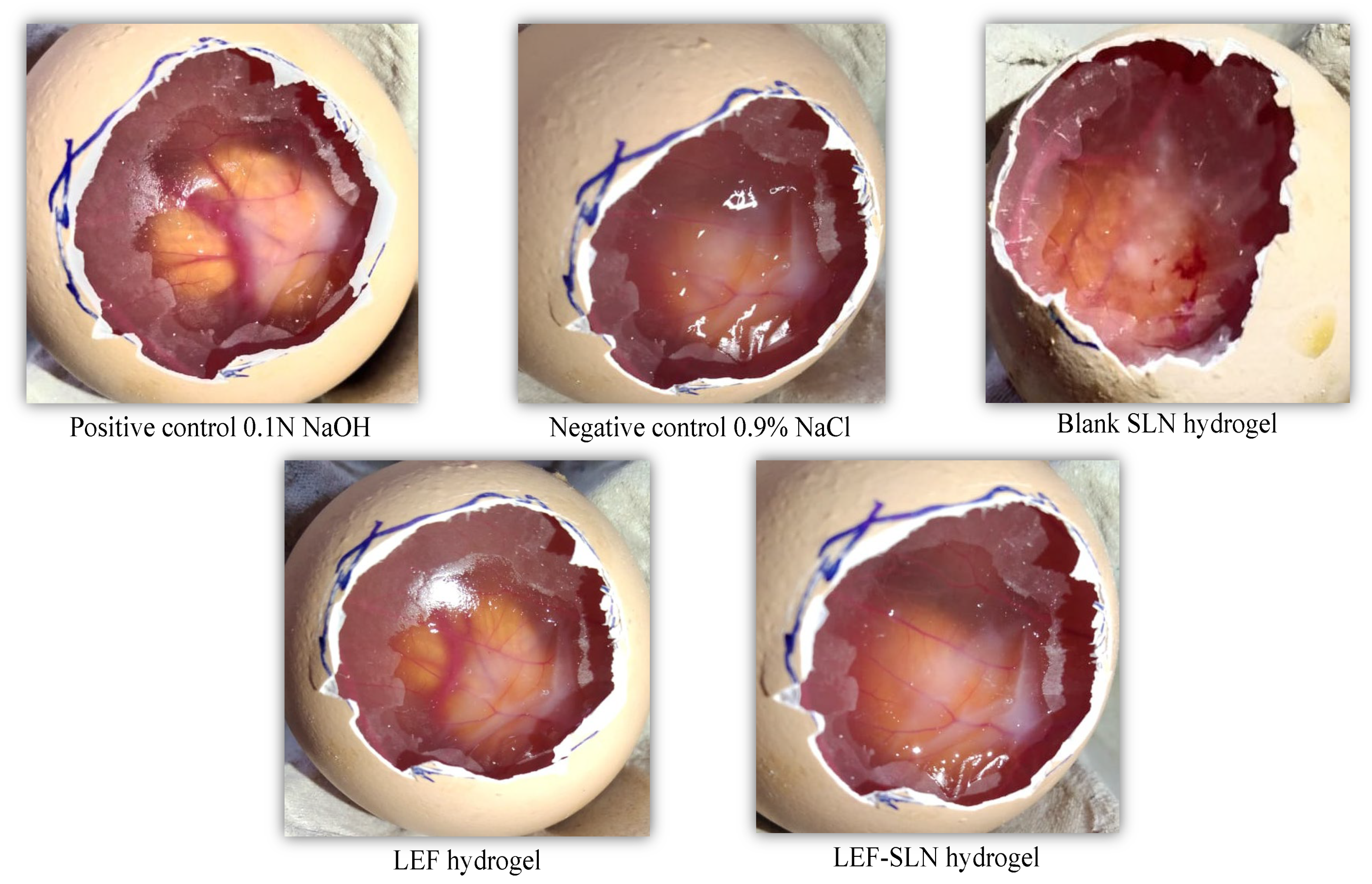

| Time (h) | LEF in Aqueous Tween® 80 | LEF-SLN Dispersions in Transparent Glass | LEF-SLN Dispersions in Amber Color Glass | |||||
|---|---|---|---|---|---|---|---|---|
| pH ± SD | Total Drug Content (%) ± SD | pH ± SD | Total Drug Content (%) ± SD | Entrapment Efficiency (%) ± SD | pH ± SD | Total Drug Content (%) ± SD | Entrapment Efficiency (%) ± SD | |
| 0 | 6.63 ± 0.05 | 99.86 ± 1.62 | 5.08 ± 0.06 | 97.29 ± 1.43 | 65.57 ± 0.05 | 5.08 ± 0.06 | 97.29 ± 1.43 | 65.15 ± 0.04 |
| 3 | 7.21 ± 0.07 | 83.02 ± 1.55 | 5.51 ± 0.03 | 88.58 ± 1.88 | 65.25 ± 0.06 | 6.11 ± 0.03 | 92.40 ± 1.54 | 64.98 ± 0.14 |
| 6 | 6.57 ± 0.06 | 67.44 ± 1.79 | 5.47 ± 0.02 | 83.16 ± 1.39 | 64.94 ± 0.04 | 5.63 ± 0.02 | 86.98 ± 1.28 | 64.96 ± 0.06 |
| 9 | 6.48 ± 0.08 | 46.57 ± 1.64 | 5.39 ± 0.03 | 77.07 ± 1.54 | 64.44 ± 0.07 | 5.49 ± 0.04 | 85.41 ± 1.67 | 64.81 ± 0.07 |
| 10 | 6.40 ± 0.07 | 27.56 ± 1.82 | 5.35 ± 0.03 | 73.62 ± 1.76 | 64.16 ± 0.10 | 5.40 ± 0.03 | 84.15 ± 1.37 | 64.45 ± 0.11 |
| Samples | Visual Appearance | pH ± SD |
|---|---|---|
| Blank SLN dispersions | Translucent | 3.26 ± 0.01 |
| LEF-SLN dispersions | Translucent | 3.51 ± 0.04 |
| Blank SLN hydrogel | Smooth translucent | 6.64 ± 0.02 |
| LEF-SLN hydrogel | Smooth translucent | 6.66 ± 0.04 |
| LEF hydrogel | Clear | 6.30 ± 0.01 |
| Time (h) | % Average Water Loss | Occlusion Factor, F | |||||
|---|---|---|---|---|---|---|---|
| LEF-SLN Hydrogel ± SD | Blank SLN Hydrogel ± SD | LEF Hydrogel ± SD | Control ± SD | LEF-SLN Hydrogel ± SD | Blank SLN Hydrogel ± SD | LEF Hydrogel ± SD | |
| 24 | 9.85 ± 0.15 | 10.77 ± 0.44 | 38.15 ± 0.19 | 42.49 ± 0.11 | 76.82 ± 0.35 a | 74.66 ± 1.03 a | 10.20 ± 0.45 |
| 48 | 10.13 ± 0.81 | 10.95 ± 1.26 | 54.67 ± 0.32 | 68.16 ± 0.26 | 85.13 ± 1.19 b | 83.93 ± 1.85 b | 19.79 ± 0.46 |
Disclaimer/Publisher’s Note: The statements, opinions and data contained in all publications are solely those of the individual author(s) and contributor(s) and not of MDPI and/or the editor(s). MDPI and/or the editor(s) disclaim responsibility for any injury to people or property resulting from any ideas, methods, instructions or products referred to in the content. |
© 2023 by the authors. Licensee MDPI, Basel, Switzerland. This article is an open access article distributed under the terms and conditions of the Creative Commons Attribution (CC BY) license (https://creativecommons.org/licenses/by/4.0/).
Share and Cite
Alhelal, H.M.; Mehta, S.; Kadian, V.; Kakkar, V.; Tanwar, H.; Rao, R.; Aldhubiab, B.; Sreeharsha, N.; Shinu, P.; Nair, A.B. Solid Lipid Nanoparticles Embedded Hydrogels as a Promising Carrier for Retarding Irritation of Leflunomide. Gels 2023, 9, 576. https://doi.org/10.3390/gels9070576
Alhelal HM, Mehta S, Kadian V, Kakkar V, Tanwar H, Rao R, Aldhubiab B, Sreeharsha N, Shinu P, Nair AB. Solid Lipid Nanoparticles Embedded Hydrogels as a Promising Carrier for Retarding Irritation of Leflunomide. Gels. 2023; 9(7):576. https://doi.org/10.3390/gels9070576
Chicago/Turabian StyleAlhelal, Hawra Mohammed, Sidharth Mehta, Varsha Kadian, Vandita Kakkar, Himanshi Tanwar, Rekha Rao, Bandar Aldhubiab, Nagaraja Sreeharsha, Pottathil Shinu, and Anroop B. Nair. 2023. "Solid Lipid Nanoparticles Embedded Hydrogels as a Promising Carrier for Retarding Irritation of Leflunomide" Gels 9, no. 7: 576. https://doi.org/10.3390/gels9070576
APA StyleAlhelal, H. M., Mehta, S., Kadian, V., Kakkar, V., Tanwar, H., Rao, R., Aldhubiab, B., Sreeharsha, N., Shinu, P., & Nair, A. B. (2023). Solid Lipid Nanoparticles Embedded Hydrogels as a Promising Carrier for Retarding Irritation of Leflunomide. Gels, 9(7), 576. https://doi.org/10.3390/gels9070576







